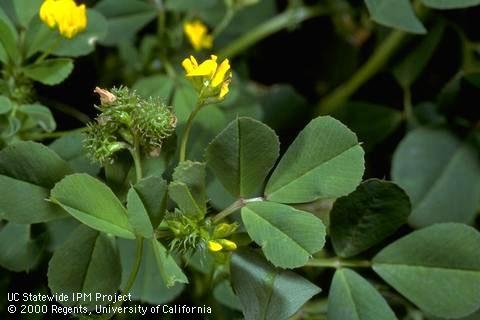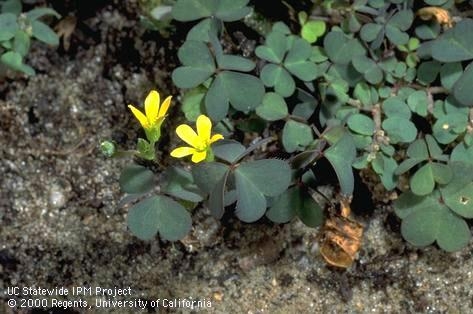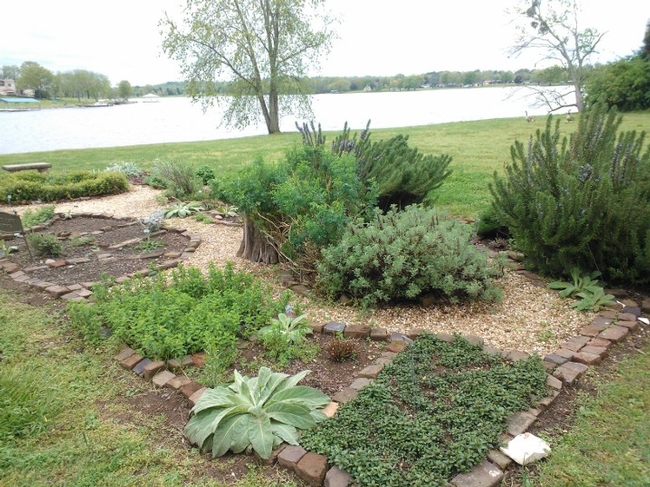- Author: Anne E Schellman
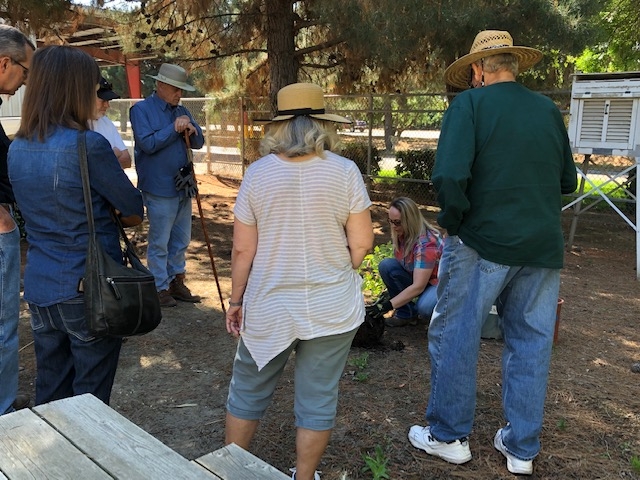
Importance of Tree Selection:
When choosing a tree, you want to select one that has the size and characteristics suitable for your site. A well-chosen tree can save up to 15% in energy costs. And, a tree in front of a home can increase the appraised value* of a home by over $7,000!
However, if you select the wrong-size tree for your landscape, you could end up with problems such as:
· A tree that grows into a power line
· A large tree growing too close to your house
· Aggressive roots that are difficult to garden under or break up pavement
· Fruit or flowers that drop onto pavement
Importance of Planting:
Correctly planting a tree helps it get off to the right start so it can thrive for years to come. Often people bury the root ball (area of soil and roots) of trees too deeply. This makes the tree more susceptible to soil-borne diseases.
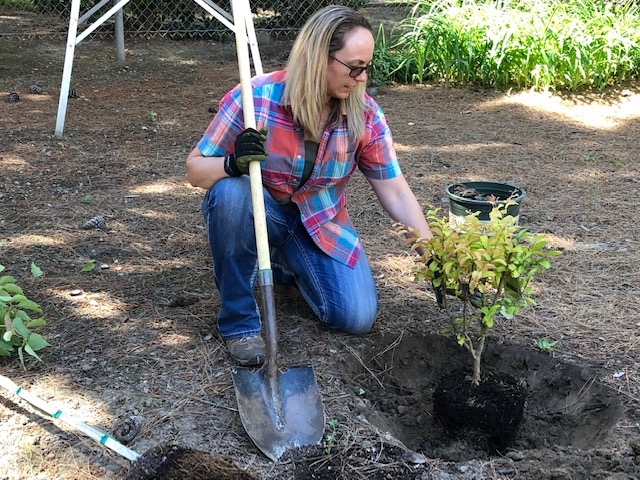
Importance of Pruning:
The first few years of a tree's life are the ideal time to prune and train a tree. Your tree should have a good structure that includes a single central leader and branches that are well spaced around the trunk. Untrained trees have a greater chance of developing limbs that break away from the tree, especially during storms or windy days.
To Stake or Not to Stake:
In most situations, it's not necessary to stake a tree. When you purchase a tree, the first thing you need to do is remove the nursery stake.
Resources:
You can pick up a free copy of our publication, Trees in Your Home Landscape from our office, or download it free from our Gardening Publications website.
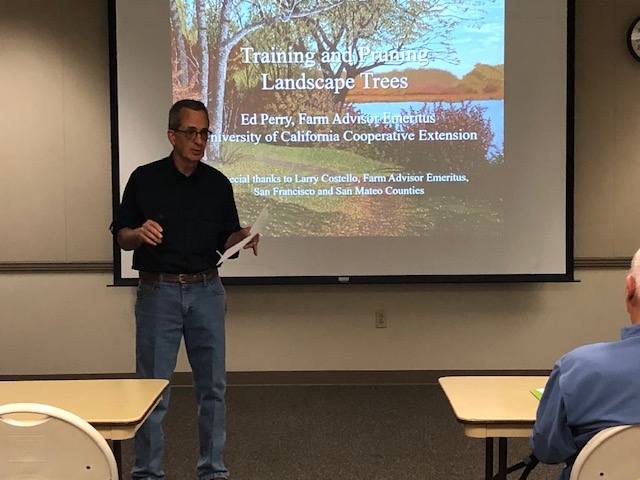
*according to the Pacific Northwest Research Station http://www.itreetools.org/news/articles/PNW_scifi126_Sept2010.pdf
- Author: Anne E Schellman
If you've been startled by insects crawling in a food package or moths flying around your kitchen, you might have a pantry pest infestation. These insects are brought into your home inside food packages such as nuts, grains, cereal products, and even chocolate!
Meal Moths
This distinctive looking moth flutters around your kitchen, distracting you from the real culprit, their larvae. These caterpillar-like insects do all the real damage when they feed inside packages of cereal, flour, rice, dried fruit, candy, and nuts. You might also see tiny webs inside packages, this is the silken cocoon of the insect before it changes into a moth. Killing off the moths won't solve your problem.
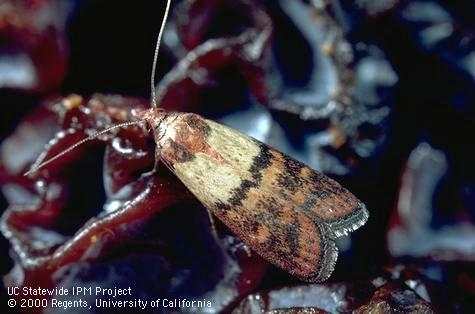
Beetles
There are several beetles that infest food, including warehouse beetles, grain beetles, cigarette beetles, and flour beetles. They feed on a variety of products including bird seed, pet food, tobacco products, animal hair (like wool), dried herbs and spices, dried meat and fruit, and even rodent bait.
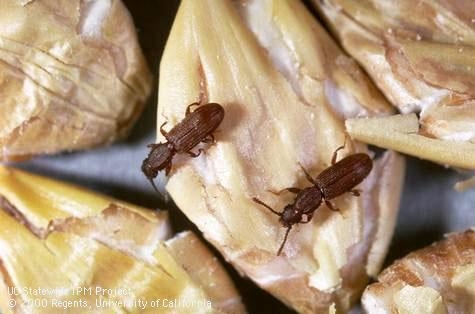
What Should You Do?
Although it might feel satisfying, spraying a pesticide is not an effective way to get rid of these pests. First, find the source of the problem. Look through all grain products and packages in your kitchen, especially opened packages. When you find the pests, seal the packages and throw them away. Remove everything from your shelves and wipe with soapy water to kill pests. Vacuum any crevices where pests or pest eggs may be hiding.
Fun Video
Watch this short video below from UC IPM for more detailed information on dealing with pantry pests. You can also read in more detail in the UC IPM Pest Notes: Pantry Pests.
- Author: Anne E Schellman
Stanislaus County herb gardening enthusiasts attended a free class on Thursday, April 11, 2019 from 6:00-7:30 p.m. from the UCCE Master Gardeners.
Attendees learned the basics on how to grow herbs from seed or transplant, and how to recognize various herbs by scent and sight by looking at examples. See if you know the answers to this "Pop Quiz" given during class:
Question#1: "What is the difference between an herb and a spice?"
Question#2: "Can you name a plant that is both an herb and a spice?"
Answer#1: The herb is the leafy part of the plant, while a spice may be the bark, seeds, or plant roots (cinnamon, mustard, or ginger).
Answer#2: Cilantro is both an herb and a spice (coriander).
Here are a few other fun facts discussed during the class:
- If you want a continuous supply of annual herbs like basil, dill, and cilantro, plant from seed every 2 weeks during the growing season.
- Tiger swallowtail butterfly caterpillars eat dill and fennel.
- You can propagate some leafy herbs by pulling off the bottom leaves of a stalk and placing them in water (mints, lemon balm).
- Chamomile and chive seeds need light to germinate. Sprinkle them on top of the soil and lightly water.
- Spearmint, peppermint, and lemon balm can quickly take over a garden space. Keep them contained in pots.
- Fennel is an invasive weed that can cause economic damage to agriculture and the environment. Avoid planting if you live around farms or open spaces.
- Pests also like herbs! If you have damage on your plants, bring in a sample to the UCCE Master Gardeners for help.
Future Events
How to Select, Plant, & Prune Landscape TreesSaturday, April 27, 2019 9:00 am to noon ($10) register now! http://ucanr.edu/trees2019
Coming This Summer and Fall
Low Water Landscaping
Pest Management In & Around the Home
Attracting Pollinators to Your Garden
Fall Vegetable Gardening for Beginners
Please visit http://ucanr.edu/scmg to see class updates.
- Author: Ed Perry
Aphids are a common garden pest in spring and are attracted to new, succulent plant growth. This year, heavy aphid infestations can already be found on roses and fruit trees.
Aphids often first show up along the edges of the garden. Many species infest the undersides of leaves first, so turn leaves over while looking for aphids. On some plant species, especially plum and apple trees, aphid feeding causes the leaves to curl. Once this happens, it's harder to obtain control because the curled leaves protect the pests from natural enemies or sprays.
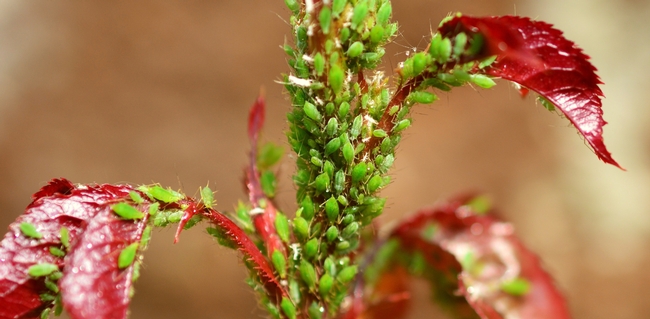
When you find aphids, check for evidence of natural enemies like lady beetles, lacewings, syrphid fly larvae, and the mummified skins of parasitized aphids. Learn to recognize aphid “mummies,” as they indicate the presence of tiny parasitic wasps that lay eggs inside the aphids. The wasp larva hatches and feeds inside the aphid, killing it. The skin of dead aphids turns crusty and golden brown or black, a form called a mummy. Not long after, the adult wasp chews an exit hole and emerges from the aphid's body. During warm weather, parasitic wasps may have several generations and cause a rapid decline in aphid populations.
There are fungus diseases that infect aphids, especially when it's warm and humid. Entire populations of aphids may be killed when conditions are right. While aphids thrive under mild temperatures, populations of many species are reduced by hot summer weather conditions. If you have any of these natural controls at work, the aphid population may crash rapidly.
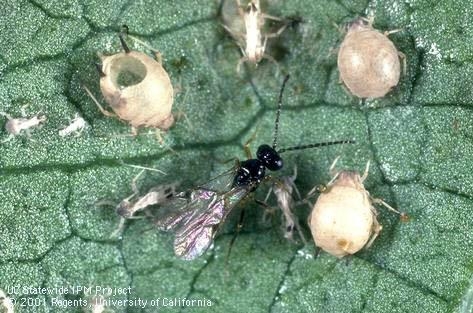
You may be able to control aphids in your trees by controlling ants. If large numbers of ants are seen climbing up and down tree trunks, it may mean an aphid infestation. Ants are attracted to the honeydew produced by the aphids. If you plan to use pesticides for ant control, first seek out and treat the ants' nests in the ground near the tree. Or, place sticky barriers around the tree trunk to keep the ants from reaching the aphids. Unprotected by the ants, the aphids may then be attacked by natural enemies.
You can help prevent aphid infestations, especially in vegetables, by removing weeds where aphids may be building up. Also, check transplants for aphids and remove them before planting. If you notice a few curled leaves on your fruit trees, the best control may be to simply prune out and dispose of the infested shoots and leaves.
- Author: Anne E Schellman
Recently, someone called our office needing help identifying a plant he said was taking over his landscape and crowding out his other plants. The caller noted that the original patch of this plant had doubled in size since last year. He described it as having clover-like leaves and yellow flowers. This fits the description of several weeds, including:
- Bermuda buttercup (also called buttercup oxalis)
- California burclover
- Creeping woodsorrel
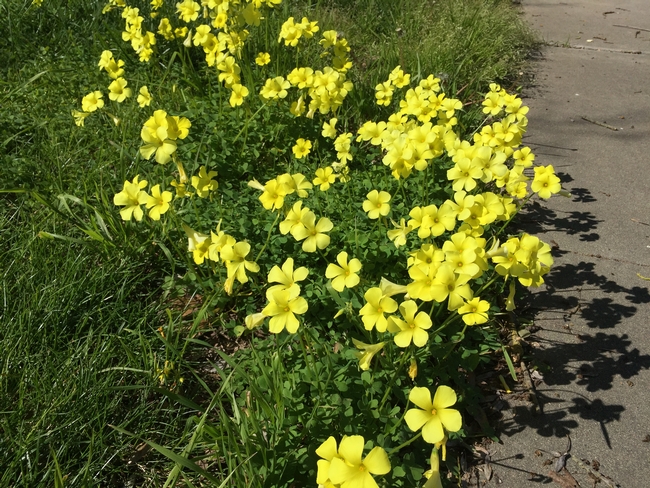
This time of year, Bermuda buttercup is prominently seen in the landscape, especially in shady areas. I suspected he might be describing this weed, so I asked if he was willing to dig up a plant and look for bulbs. After a moment of digging, he said, “Yes! I've found some small brown bulbs!” This confirmed the weed was indeed Bermuda buttercup.
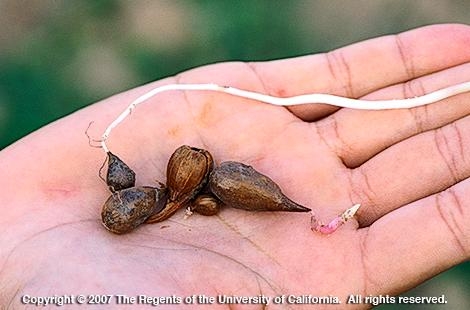
In his landscape, Bermuda buttercup had taken over a 50 square-foot area and was growing in and around other ornamental landscape plants. I used the online IPM Pest Notes: Creeping Woodsorrel and Bermuda Buttercup to tell him more about this weed.
The publication recommends manual removal of the whole plant, including the bulbs. However, you can hand pull or mow the top to deplete the bulb reserves but killing the plant this way could take years.
The caller had trouble bending over and digging and hoped he could use an herbicide to kill the weeds. Unfortunately, herbicides will only kill the top portion of the plant, which will regrow. Also, if they drift to garden plants, the herbicides listed in the publication can kill them.
I recommended he call a local nursery or garden center and ask for the contact information of a professional landscaper or gardener for help digging out the weedy bulbs.
If you have one of the other two weeds mentioned in the above list, visit the Clovers Pest Notes for more information.
For identification and management help with weeds in your garden or landscape, bring in a sample to the UCCE Master Gardeners at 3800 Cornucopia Way Ste A, Modesto, CA 95358 or call (209) 525-6800.
